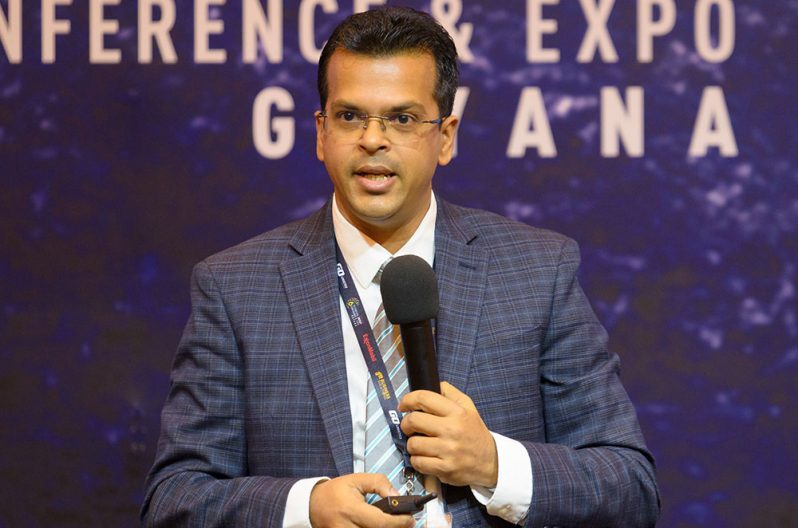-$31B spent in 2021, GEA head says
GIVEN the large sums of money that are being spent every year on importing fuel to meet the country’s electricity needs, much focus will be placed on developing renewable energy sources.
This is according to Chief Executive Officer (CEO) of the Guyana Energy Agency (GEA), Dr Mahendra Sharma, who highlighted the high cost of fuel imports, on Thursday, at the 2022 International Energy Conference and Expo.
He said in 2021, government spent $31 billion on fuel imports to cater to the growing electricity needs of the country.
According to him, Guyana’s energy imports amounted to about 20,300 barrels per day in 2021. This represented 0.02 per cent of the global daily fuel import, which sits at 99,000 barrels per day.
About 78 per cent of the fuel purchased was used to power the Demerara-Berbice Interconnected System (DBIS), which is Guyana’s main power supply system. It is powered by the Guyana Power and Light (GPL).
“Our expenditure for those fossil fuel imports for the electricity sector amounted to US$150 million in 2021. The Demerara-Berbice Interconnected System (DBIS), the grid that is providing much of the electricity accounts for about 78 per cent of that total cost, but capacity is needed to cover that growing demand,” Sharma said.
He noted that Guyana over the next eight years is aiming for economic growth from the use of fossil fuels for electricity generation by developing low-carbon energy resources inclusive of solar, hydropower, wind and natural gas to meet its rising demand and keep greenhouse gas emissions low.
ENERGY 2022
The government has budgeted significant sums of money to undertake several energy-related projects in 2022. Those allocations are part of the government’s plan to transition to cleaner sources of energy, and reduce the country’s carbon footprint. In the 2022 budget, the government has allocated $29.4 billion to the energy sector.
Speaking to the significant benefits of solar power alone, Sharma stated, “In one hour and 20 minutes we receive the same amount of energy that we consume for an entire year…from the sun; in one hour and 20 minutes so the potential for solar is huge.”
$1.1 billion of the sector’s budget is earmarked for solar farm interventions in 2022. These include the completion of the 1.5 MW solar farm at Bartica, the 0.75 MW farm at Wakenaam, and the 1.0 MW farm at Lethem. It is also the government’s intention to tender for the construction of a 0.6 MW solar farm at Leguan and a 0.65 MW farm at Mahdia later this year.
Several projects are ongoing to improve energy access, and these include investments in solar photovoltaic (PV) systems in off-grid areas and the development of micro-grids for large hinterland areas.
Specifically, the projects entail the installation of 13 utility-scale solar farms, 30,000 solar home systems for hinterland riverine communities, 20 Solar PV grids for public buildings in the hinterland, over 180 PV stand-alone systems for government ICT hubs and the installation of a 3 MW grid connected solar PV system at the Cheddi Jagan International Airport.
“The installed capacity for the solar farms alone represents 39 megawatts over the next few years, 13 solar farms, and 28 solar mini grids,” said Sharma.
The GEA head noted that by 2030, 30 per cent of Guyana’s energy is going to come from renewable energy and by 2040 that goes up to 70 percent with a combination of hydro, wind and solar.
HYDROPOWER
With the planned micro-hydropower systems, a total of 2.35 MW of power will be added to serve hinterland communities by 2024.
Over $600M has been budgeted for the construction of a 1.5 MW hydropower plant at Kumu, and rehabilitation and upgrade to 700 KW capacity of the defunct Moco Moco hydropower plant in Region Nine.
Additionally, over $170 million has been budgeted for the completion of the 150KW hydropower scheme at Kato.
In a bid to further reduce greenhouse gas emissions, the government will distribute and install over 22,000 LED bulbs and over 12,000 LED tubes in homes, businesses, and government buildings at Bartica, Linden, Leguan, and Wakenaam.
The initiative, which is anticipated to remove over 500 tonnes of carbon dioxide emissions from the environment, is part of the government’s plans to reduce the country’s carbon footprint.
Also this year, the government will pilot the installation of fast-charging stations for electric vehicles in Region Three (Essequibo Islands-West Demerara), Region Four (Demerara-Mahaica) and Region Six (East Berbice-Corentyne).
Combined with these efforts, the 165 MW Amaila Falls Hydropower Project will lower the cost of electricity needed to fuel Guyana’s economic diversification and transformation into a low-carbon economy, as well as reduce the cost of power to businesses and households.



.jpg)








